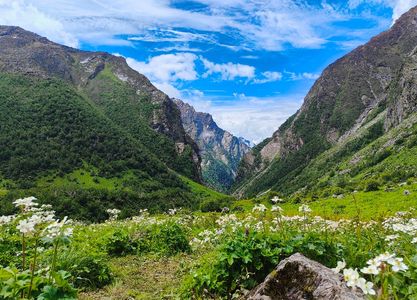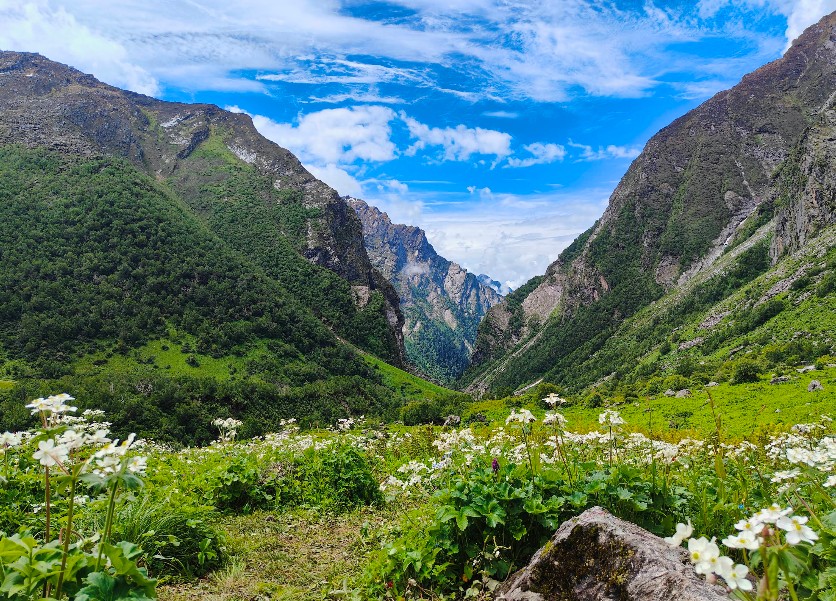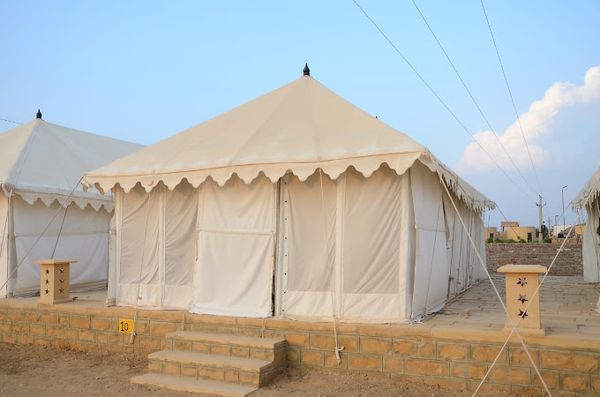Ultimate Guide to Valley of Flowers National Park, Uttarakhand, India
 Mountains Curve
03 Aug, 2025
31 mins read
280
Mountains Curve
03 Aug, 2025
31 mins read
280

The Valley of Flowers National Park is a high-altitude Himalayan sanctuary famed for its alpine meadows of wildflowers and outstanding natural beauty. Nestled in Chamoli district, Uttarakhand, it forms a core part of the Nanda Devi Biosphere Reserve.
The gentle green valley floor of park is framed by snow-capped peaks and cut by the glacial Pushpawati River. This pristine valley is renowned for its meadows of endemic alpine flowers and outstanding natural beauty, and it supports rare, endangered fauna.
Protected since 1982 and designated a UNESCO World Heritage Site (originally with Nanda Devi in 1988, expanded in 2005 to include the valley), the park draws hikers, photographers and botanists worldwide.

Geography and Location
The Valley of Flowers lies in the western Himalaya, in the Chamoli district of Uttarakhand (Garhwal region). It sits within the Nanda Devi Biosphere Reserve, at altitudes roughly 3,350 to 3,650 meters above sea level.
The park covers about 87.5 km² (roughly 8 km long by 2 km wide). It is a classic high-altitude hanging valley of the Pushpawati River, tributary to the larger Alaknanda basin.
On the west side looms Gauri Parvat (6,719 m) and nearby rises Nilgiri Parbat, while eastward are the peaks of Ghori Parbat and Hathi Parvat (the Elephant Peak).
Steep rocky ridges and glaciers bound the valley; from mid-summer to early autumn, snowmelt feeds glacial streams and waterfalls that irrigate the meadows.

- Coordinates & Map: The valley lies roughly at 30.70°N, 79.62°E. The surroundings are fully alpine/temperate climate with heavy monsoon rains (June to September) and snow winters.
- Unique Setting: UNESCO notes that the gentle landscape of Valley of Flowers National Park complements the rugged mountain wilderness of Nanda Devi National Park, forming a unique transition zone between Zanskar and Great Himalaya. In other words, lush grasslands grade into the severe high Himalaya of the valley, a reason why mountaineers and botanists have long praised it.
- Altitude & Climate: At ~3,500 m, temperatures range from around 10 to 18 degree celsius by day in summer (July to August) down to a few degree celsius at night. Heavy snowfall typically covers the valley in winter; the park is generally accessible June through October.
Historical Background and Discovery
Locally, the valley was likely known to alpine shepherds and pilgrims for centuries. In Hindu legend, it is identified with Nandankanan, the heavenly garden of Lord Indra.
Indeed, local lore says Hanuman brought a healing mountain here to save Lakshmana, so the medicinal plants valley have mythic status.
In modern times, the Valley was discovered by outside science in 1931 when British climber Frank S. Smythe, returning from a climb of nearby Kamet, stumbled upon the hidden valley.
Expedition of Smythe named it the Valley of Flowers. (Smythe later published a famous book Valley of Flowers recounting the experience.) Notably, the valley had actually been noted earlier by British army officer Colonel Edmund Smyth in 1862, but 1931 visit of Smythe popularized it in botany and climbing circles.
Smythe and his team were attracted by the beauty of the valley and gave it its name. Over the 1930s and 40s, further exploration occurred (tragically, botanist Joan Legge died of a leopard attack here in 1939).
In recognition of its unique ecology, the Government of India declared Valley of Flowers a National Park in 1982 to protect its delicate flora (along with Hemkund Sahib area).
In 1988, the Nanda Devi National Park (adjacent to the east) was inscribed as a World Heritage Site, and in 2005 the protected area was expanded and officially renamed Nanda Devi and Valley of Flowers National Parks. Today it remains a strictly protected core zone of that UNESCO reserve.
Biodiversity: Endemic Flora and Fauna
The Valley of Flowers is a botanical treasure and biodiversity hotspot. Surveys report on the order of 600+ plant species within the park, many of which are endemic to the Himalaya.
Research by botanist C. P. Kala and others found approximately 520 species of higher plants in the park, of which nearly 498 are flowering plants (angiosperms). Common families include roseroots, primulas, gentians, poppies, geraniums, orchids and bluebells. The valley bursts into bloom with over 600 species of wildflowers during the monsoon. Key iconic blooms include:
- Brahma Kamal (Saussurea obvallata): A sacred Himalayan lily that blooms in late summer around 4,000 m.
- Himalayan Blue Poppy (Meconopsis aculeata): A rare sky-blue poppy found in subalpine meadows.
- Himalayan Cobra Lily (Arisaema costatum): A bizarre spathe-like flower common along stream banks.
- Rhododendrons: Various species adorn the lower slopes in patches.
- Primulas, Saxifrages, Anemones, Marsh Marigolds, and countless primula species (primroses) carpet the valley.
These wildflowers form a vibrant floral carpet each summer. In early July the valley greens up (snow still lingers), and by July to August peak bloom occurs. (By September the flowers begin to fade, replaced by clear mountain views.)
An embedded photograph below illustrates this rich flora: High-altitude wildflower (a primrose) in the Valley of Flowers. The alpine meadows park harbor hundreds of flowering plant species (over 600 in all).
Regarding fauna, the valley and surrounding forests support a variety of high-altitude Himalayan wildlife.
Though populations are relatively low, many species are rare or endangered:
- Asiatic Black Bear (Ursus thibetanus): Roams the forested fringes.
- Snow Leopard (Panthera uncia): Occasionally found in the crags above (surveys have confirmed their presence).
- Brown Bear (Ursus arctos): Known from the region.
- Blue Sheep or Bharal (Pseudois nayaur): Often grazing on alpine pastures and rocky slopes.
- Musk Deer: Small deer valued in wildlife trade (found at tree-line).
- Red Fox: A common forest denizen.
- Himalayan Monal (Lophophorus impejanus): A brilliantly colored pheasant, and the state bird of Uttarakhand, is frequently seen.
Butterflies, insects and a few amphibians also thrive in this ecosystem. This unique community, alpine meadows to shrub forests, attracts botanists and ecologists worldwide, as it harbors numerous endemics and medicinal plants (for example, the Brahmkamal is prized in herbal medicine).
Trek Route and Itinerary of Valley of Flowers Trek
The Valley of Flowers trek begins from Govindghat, and spans a 40 km round trip, typically completed in 5 to 6 days. The trail meanders through dense forests, cascading waterfalls, gushing streams, and wooden bridges, making every step an experience of finest artwork of nature. The route leads to Ghangaria, a quaint hamlet that acts as the base camp for both the Valley of Flowers National Park and the sacred Hemkund Sahib, a high-altitude Sikh pilgrimage site located at 4,329 meters. The steep ascent to Hemkund Sahib is demanding, but the panoramic views of snow-capped Himalayan peaks from the top are immensely rewarding.
Day 1: Rishikesh to Joshimath
Begin early from Rishikesh. Travel via NH7 passing Devprayag (Bhagirathi-Alaknanda confluence), Rudraprayag (Mandakini-Alaknanda), Karnaprayag (Pindar-Alaknanda), and Nandaprayag (Nandakini-Alaknanda). Reach Joshimath by evening. Explore the market for essentials and rest overnight in a guesthouse.
Day 2: Joshimath to Ghangaria via Govindghat & Poolna
Drive to Govindghat, visit Gurudwara Sahib, then take a shared taxi to Poolna (5 km). Begin your 10 km trek to Ghangaria. En route, pass Jungle Chatti, Bhyundar Village (Hathi Parbat views), and Laxman Ganga stream. Reach Ghangaria by evening and rest in homestays or GMVN.
Day 3: Valley of Flowers Trek
Start early, get permit at the gate 1.5 km from Ghangaria. Walk along Pushpawati River, cross bridges, waterfalls, forest trails, and reach scenic spots like Baman Dhaud Bridge and Kunth Khal Marg. Spot alpine flowers, visit memorial of Lady Legge, and enjoy views of Gauri Parbat and Rataban. Return to Ghangaria by 5 pm.
Day 4: Hemkund Sahib Trek
Begin early for the 6 km steep trek to Hemkund Sahib (4,329 m). Witness glacier patches, Hemkund Lake, and Brahma Kamal flowers. Visit the Gurudwara and Lokpal Temple. Enjoy langar before descending back to Ghangaria by evening.
Day 5: Ghangaria to Joshimath
Trek back to Poolna and drive to Govindghat. Continue to Joshimath. Explore Narsingh Temple or visit Auli/Badrinath if time permits. Overnight stay at Joshimath.
Day 6: Joshimath to Rishikesh
Drive back to Rishikesh with Himalayan views. Buffer an extra day during monsoons due to possible landslides.
Difficulty and Safety
Though non-technical, the Valley trek has significant altitude (up to ~14,000 ft). The main difficulty of Valley of Flowers trek is the steep, rocky ascent and monsoon weather. Key points:
- Moderate Grade: Classified as moderate, it suits most healthy trekkers and even older children. The paths are clear, with occasional ladders or rope sections near Hemkund.
- Altitude and Acclimatization: The trek rises quickly; hikers may experience mild altitude effects near Ghangaria/Hemkund. A night in Ghangaria helps acclimatize.
- Monsoon Hazards: Rains can make the path slippery and cause stream crossings. Landslides and roadblocks to Govindghat are common in heavy rains. Always check weather forecasts. The Uttarakhand Tourism Authority and trek organizers advise travelers to start early and aim to be off trails by early afternoon, as rains intensify later.
- Wildlife & Safety: The area is largely safe; the only concern is leeches in wet patches or occasional bear; standard wildlife precautions suffice.
Permits and Regulations
Entry to the Valley of Flowers requires permits and fees regulated by the Uttarakhand Forest Department. Key rules:
Permits Required: Every visitor must obtain a park permit before trekking. Permits are issued at the Forest check-post in Ghangaria (Govindghat also has one).
These cost ₹150 for a 3-day pass (per Indian adult), plus ₹50 for each extra day. Foreign nationals pay higher fees (₹600 for 3 days).
Permit booths open daily; one must also show valid ID (Aadhaar, voter ID or passport) when buying the permit. The permit must be carried on the trek. Camping, fires and smoking are banned.
Photography/Videography: Casual photography with small cameras is generally allowed (and encouraged) in the meadows of the valley. However, there are fees and rules for professional equipment or filming.
If you carry a DSLR with a large telephoto lens (≥300mm), a small photography fee may apply. Filming a documentary or using a drone requires prior permission from the PCCF/Wildlife Department.
In general, drones are not permitted without authorization (and are discouraged, given noise disturbance and park rules).
Conduct: Visitors must stick to marked trails, not pluck plants or disturb animals. No commercial activities are allowed in the park, no shops, hotels, or commercial activity can exist inside.
Porters and mules are available up to Ghangaria (often used to carry gear) but motorized vehicles are not allowed beyond Pulna.
Best Time to Visit Valley of Flowers
The Valley of Flowers opens from June 1 to October 31 each year (subject to weather). However, the peak bloom season is mid-July through August, during the monsoon.
The best time to visit Valley of Flowers is from mid-July to mid-August. By late June some flowers begin to appear, but heavy snowfall may still block sections of trail; by late August to September many blossoms have wilted, though the weather clears up.
- July to Early August: lush meadows with peak variety of flowers (especially rhododendrons, primulas, gentians, etc.). Trails may have snow patches early in July, then rains start in late July. Trek crowds are high in August (especially holiday weeks).
- Late June: green valley, few flowers, cooler, fewer trekkers, risky due to snow.
- September to October: fewer flowers, but clearer skies and panoramic mountain views as monsoon retreats. Also pilgrim traffic to Hemkund Sahib peaks in Sept.
In summary, July and August are ideal for the floral spectacle. (During peak monsoon, trekkers should start early each day to avoid afternoon storms.) August offers the fullest bloom, but advantage of July is somewhat lighter crowds.
Mythological and Cultural Significance
The Valley of Flowers holds cultural and spiritual resonance in Hindu tradition. According to legend, it is the earthly manifestation of Nandankanan (Garden of Indra, the king of gods).
Ancient texts link this alpine valley to the epic Ramayana: it is said that the monkey-god Hanuman once brought a portion of the Kailash Mountains (rich in life-saving herbs) to the valley to help heal Lakshmana (brother of Rama).
This myth explains why many of the plants valley are regarded as medicinal treasures. Local lore even calls it paradise of Indra, a sacred spot where deities and fairies roam.
In modern times, the nearest pilgrimage area is Hemkund Sahib, a Sikh gurudwara and sacred lake just above the valley. Legend holds Hemkund as the meditation site of Guru Gobind Singh, giving the trek a unique blend of nature and devotion.
Ghangaria itself has a small Gurudwara. Many trekkers incorporate this spiritual dimension by visiting the Hemkund Sahib temple (approximately 14,100 ft) as part of the circuit. These cultural layers add depth to the trek: one not only hikes through dazzling flora, but also through landscapes steeped in Indian mythology.
Visitors often report a sense of serenity and reverence in the valley, as one writer puts it, standing amidst a natural floral carpet with misty peaks rising all around feels like actually walking inside a painting.
Conservation and UNESCO World Heritage Status
The Valley of Flowers National Park enjoys the highest level of protection under Indian law. It is managed by the Uttarakhand Forest Department as part of the Nanda Devi Biosphere Reserve core zone.
UNESCO designated the combined Nanda Devi NP and Valley of Flowers in 1988 (with the latter added in 2005) exactly for their outstanding universal value.
The statement of UNESCO praises the meadows of endemic alpine flowers and notes its gentle landscape that complements rugged Nanda Devi.
Conservation rules are strict: no grazing, woodcutting or permanent settlements are permitted. In fact, forest authorities have banned grazing since the early 1980s to prevent overuse.
Commercial activity is entirely excluded: no shops, hotels, or commercial activity can be set up inside the park. Even camping or fires are forbidden.
The result is that the alpine ecosystems remain intact and pristine. Every visitor has a role in conservation.
Trekkers and photographers are urged to follow Leave-No-Trace principles: stay on trails, carry out all trash, and refrain from picking flowers or disturbing wildlife.
Resting areas and camps are only in Ghangaria; venturing beyond marked routes is prohibited. The Uttarakhand government has also set up a research nursery and station at nearby Musadhar to propagate threatened species.
Ongoing botanical surveys continue to record new plant occurrences, underlining how the biodiversity of the valley is still being understood.
In sum, the Valley of Flowers survives today because of dedicated protection. UNESCO status not only recognizes its beauty, but also mandates international responsibility. Visiting trekkers contribute (through fees and regulations) to park upkeep. By respecting these rules, visitors help ensure this living paradise endures for future generations.
Guidelines for Researchers and Photographers
For those wishing to study or document the valley, special guidelines apply beyond the normal permit:
- Research Permits: Academic researchers (botanists, biologists, geologists, etc.) must apply for a research permit from the Forest Department. This usually involves submitting a proposal (often via Uttarakhand University or forest office) and a nominal fee. Contact the Chief Wildlife Warden, Uttarakhand (Dehradun) for formal permissions. Researchers should carry their permit and ID at all times.
- Photography Permits: Any camera (still or video) is allowed without extra permit as long as it is for personal use. However, carrying professional gear may incur fees. According to Uttarakhand park rules, tourists will have to pay additional charges if they have to use a camera. For example, an Indian tourist with a telephoto lens may be charged a small fee (typically ₹500). It is advisable to declare camera equipment when obtaining the entry permit.
- Filming/Drone Permits: Filming a feature documentary or using drones inside the park is restricted. One must get prior clearance from the Principal Chief Conservator of Forests (Wildlife) or the Chief Wildlife Warden in Dehradun. For example, a professional film crew must pay substantial fees (₹10,000 per day for documentary, much more for commercial films) and submit a refundable deposit. Drones and aerial photography are not permitted without explicit permission and often are flatly banned for conservation reasons.
- Other Rules: No camping or sleeping outside Ghangaria lodgings. Researchers should also avoid marking or carving on trees/rocks. Collection of any plant or animal material requires special clearances, and is generally prohibited.
In short, plan ahead: carry multiple IDs, purchase permits at Ghangaria well in advance, and declare camera gear at the check-post. This ensures a hassle-free experience while complying with park regulations.
How to Reach Valley of Flowers
- Nearest Airport: The closest airport is Jolly Grant Airport (Dehradun), about 290 to 300 km from Govindghat. From Dehradun one can hire a taxi or take a bus (via Rishikesh/Haridwar) to reach Joshimath/Govindghat.
- Railway: The nearest major railway station is Rishikesh (~270 km away). Trains from Delhi/Haridwar terminate here. From Rishikesh, frequent buses and shared jeeps run to Joshimath/Govindghat.
- Road to Govindghat: Govindghat (1,829 m) is the road-head for the trek. It lies on the Rishikesh to Badrinath highway, ~25 km before Badrinath and ~20 km after Joshimath. In summer, state-run buses and private cabs connect Govindghat to major towns like Rishikesh, Haridwar and Dehradun. During monsoon, landslides can block roads, travelers are advised to allow extra travel time.
- Govindghat to Ghangaria: From Govindghat drive ~4 km to Pulna (last village) by shared taxi or rented jeep. Pulna is the trekking base at 2,200 m.
- From Pulna begins the trail: it is a 10 km trek to Ghangaria (Govinddham), crossing forest and river trails. The trail is stone-paved; mules and porters are available for hire up to Ghangaria. Ghangaria (3,189 m) is a tiny settlement with basic guesthouses, cafés and the Gurudwara.
- Ghangaria to Valley: The Valley of Flowers lies 3 to 4 km further up (to the north) from Ghangaria. The trek from Ghangaria to the valley and back can be done in one day (round-trip 7 to 8 km). The trail passes through dense oak/birch forest before opening into the flower meadows.
- Local Transport Summary: Many trekkers hire a cab for the entire route (Rishikesh→Govindghat) which may cost ~₹7,000 to 10,000 per vehicle (one way). State buses are cheaper. Due to remote terrain, arrive at Govindghat/Pulna by late afternoon to avoid last-mile difficulties.
Where to Stay
Govindghat: A few hotels and lodges serve as stopovers. Many trekkers prefer to overnight here the day before the trek. Reservations are generally not required for moderate-budget lodging.
Ghangaria: This is the only place to stay near the park (there are no guesthouses inside the park). Ghangaria has 20 small guesthouses and dhabas. During peak season (July to August), book in advance.
Accommodation is basic (twin-bed rooms, communal bathrooms). Popular lodges include GMVN guesthouse (run by Uttarakhand tourism) and private homestays. Prices are modest (₹800 to 1500 per night). Electricity and internet are limited. Gem stores sell fuel, snacks, and cold drinks.
Packing Tips: Trekkers should pack warm layers (nights can be cold even in summer) and rain gear. Good hiking boots are essential. Note that water is potable from streams (with iodine filter if needed), and simple eateries provide meals in Ghangaria.
Regulations to Visit Valley of Flowers
- Park Timings: The park gates are open from June 1 to October 31 (depending on weather). Daily entry is from ~7:00 AM to 5:00 PM. Visitors must buy permits before 2:00 PM and exit by evening.
- Entry Fees: As of 2025, fees are ₹150 for Indian adults (3-day pass) and ₹600 for foreigners. Fees are collected at Ghangaria check-post; keep the receipt with your permit. (There are additional nominal fees for cameras or extended days as noted.) Carry a photo ID to show when paying fees.
- Guides/Porters: Hiring a local guide is optional but recommended for first-timers. Porters and mule rides (for gear or even persons) can be arranged in Pulna/Ghangaria. For conservation, only mules (no motor vehicles) may go up to Ghangaria.
- Rules: Staying off-trail, littering, smoking, and wood-gathering are prohibited. Plucking flowers or plants is illegal. Domestic animals are not allowed in the park. Do not feed wildlife, even monkeys or crows, as it disrupts their diet.
By following these guidelines, trekkers help preserve the fragile ecosystem the valley. For updates, check the official Uttarakhand tourism website or local forest ranger station in Ghangaria.
Practical Tips for Trekkers, Photographers and Botanists
- Acclimatize: Spend the first night at a lower elevation (Govindghat/Pulna) before ascending to Ghangaria. Move slowly the first day to avoid altitude sickness.
- Clothing: Layered clothing is best, include a warm jacket, woolen hat, and rainproof outerwear. Even summer evenings can drop to near freezing. Trekking poles are very helpful on slippery or uneven sections.
- Photography: The valley is a paradise for photographers. Cameras should have charged batteries (cold drains power). Macro lenses capture the myriad flowers; wide lenses capture sweeping vistas. Be mindful of other trekkers on narrow trails when stopping to shoot. As noted, commercial or drone photography requires permits.
- Botanical Study: Botanists should bring plant presses or high-quality camera equipment. Do not remove plants from the park. Local guides can often identify species. Carry binoculars to observe birds and distant wildlife.
- Health & Safety: Carry first-aid, water purification tablets, sunscreen and insect repellent. Stock extra water and snacks for longer treks in case of delays. Before the monsoon, rivers can swell, if heavy rain is forecasted, postpone crossing any bridge.
- Weather: Check forecasts for Uttarakhand (Govindghat area). Road travel beyond Govindghat can be disrupted by landslides, so plan buffer days before/after the trek.
- Cultural Respect: The region is devoutly religious. Dress modestly when visiting Hemkund Sahib; follow local customs (remove shoes in the gurudwara). Locals in Ghangaria and Govindghat will appreciate polite behavior and support of eco-friendly practices.
Conclusion
Valley of Flowers National Park is an exceptional Himalayan destination that combines adventure, natural wonder and cultural lore.
Trekkers find a stunning trail through mountain forests and flowered meadows. Botanists discover rare alpine species and living landscapes straight out of mythology. Photographers capture a kaleidoscope of colors beneath majestic peaks. And conservationists celebrate a pristine ecosystem safeguarded by UNESCO.
Whether you trek its trails or study its blooms, remember that this valley’s beauty is finite and fragile. Plan responsibly, respect regulations, and embrace the serene spirit of the valley. By doing so, you help keep the living paradise flourishing for the trekkers, nature lovers and scientists of tomorrow.
Written By:
Mountains Curve



Hotels at your convenience
Now choose your stay according to your preference. From finding a place for your dream destination or a mere weekend getaway to business accommodations or brief stay, we have got you covered. Explore hotels as per your mood.





